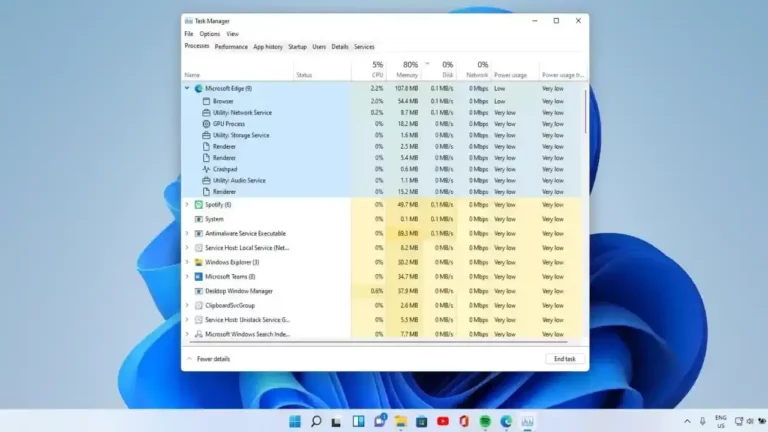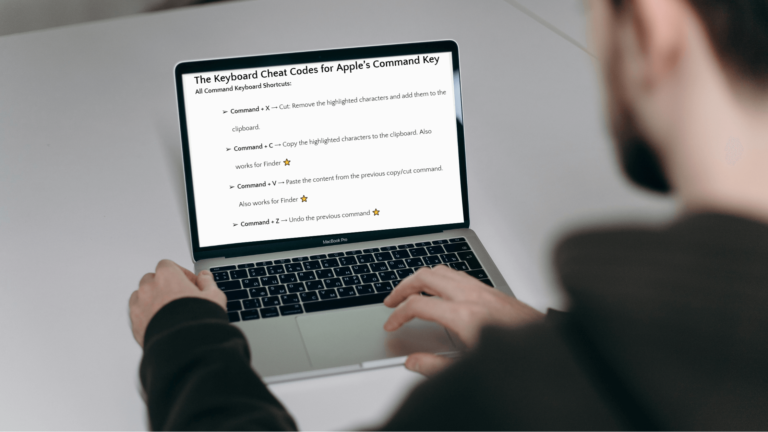In the fast-paced world of IT support, time is truly of the essence. But hey, what if I told you there’s a way to shave off precious seconds and make your work more efficient? Sounds too good to be true, right? Well, sit tight because we’re about to dive into the realm of the Top 10 Useful Keyboard Shortcuts for IT support, a secret sauce that every IT pro should have in their toolkit.
Ctrl + C and Ctrl + V: The Dynamic Duo
Alright, let’s start with the basics. Known as the dynamic duo, the “Ctrl + C” and “Ctrl + V” commands for copy and paste, respectively, are the bread and butter of keyboard shortcuts. When dealing with repetitive tasks, these commands can be real-time savers.
Ctrl + Z and Ctrl + Y: The Time Travellers
Ever wished you could turn back time? With “Ctrl + Z”, you can! This command undoes the last action. Its counterpart, “Ctrl + Y”, redoes the undone action. It’s like having a mini time machine right at your fingertips.
Alt + Tab: The Swift Navigator
Got a bazillion windows open? No sweat! With the “Alt + Tab” command, you can swiftly navigate through all your active windows. It’s like having a personal assistant to manage your desktop clutter.
Ctrl + S: The Lifesaver
Imagine you’ve been working on a lengthy document or a complex code and the power goes out. Nightmare, right? The “Ctrl + S” command for saving your work can be your knight in shining armor. Make a habit of using this shortcut frequently to prevent data loss. Trust me, your future self will thank you.
Ctrl + F: The Eagle Eye
Looking for something specific in a haystack of information? “Ctrl + F” is your best bet. This shortcut opens the search box in most applications, allowing you to find specific text in no time. It’s like having an eagle eye for detail.
Win + L: The Guardian
Stepping away from your desk for a while? The “Win + L” command locks your computer, protecting it from prying eyes. This simple yet essential shortcut keeps your confidential data safe and secure.
Creating Your Own Shortcuts: Unleashing True Potential
Did you know that you can create your own keyboard shortcuts? Here’s how to unleash your true productivity potential.

Custom Shortcuts in Windows
In Windows, you can assign a keyboard shortcut to launch your favorite applications. Let’s see how you can do this in a few simple steps.
Creating Custom Keyboard Shortcuts on Windows PC
The steps for establishing shortcuts to your favorite applications:
- Locate the Application: Navigate to the application for which you want to create a shortcut. You can typically find it on the desktop or the start menu.
- Shortcut Creation: Right-click on the application icon, and select ‘Properties’ from the drop-down menu. In the ‘Shortcut’ tab, you will see a field named ‘Shortcut key’.
- Enter Shortcut: Click on the ‘Shortcut key’ field and press the key you want to use for your shortcut. Windows will automatically add the ‘Ctrl + Alt’ prefix.
- Save: Click ‘Apply’ and then ‘OK’ to save your new shortcut.
Custom Shortcuts on Mac
Creating custom keyboard shortcuts on Mac might seem a bit daunting, but fear not! We’ve got you covered with this easy guide.
Steps to Create Custom Keyboard Shortcuts on Mac:
Follow the steps below and you’ll have your shortcuts set up:
- Accessing the Keyboard Shortcuts Menu – First, click on the Apple logo located in the top-left corner of your screen. From the drop-down menu, select ‘System Preferences.’ In the new window that opens, locate and click on ‘Keyboard,’ and then select the ‘Shortcuts’ tab.
- Creating a New Shortcut – To create a new shortcut, select ‘App Shortcuts’ from the left pane of the ‘Shortcuts’ tab. Click on the ‘+’ button below the right pane. A small dialogue box will pop up.
- Designating Your Shortcut – In the dialogue box, there are two fields: ‘Menu Title’ and ‘Keyboard Shortcut.’ Type the exact name of the action as it appears in the application’s menu in the ‘Menu Title field. Then, click on the ‘Keyboard Shortcut’ field and press the keys you want to use as your shortcut.
- Saving Your Shortcut – Once you’ve designated your shortcut, click ‘Add.’ Your new custom shortcut will now appear in the list of app shortcuts.
Troubleshooting Custom Shortcuts
Occasionally, you might encounter a hiccup when creating your custom shortcuts. Here are a few tips to help you troubleshoot any issues.
Duplicate Shortcuts
If your new shortcut isn’t working, it could be because the key combination is already being used elsewhere. To avoid this, try to choose unique combinations for your custom shortcuts.
Inconsistencies in Naming
Ensure that the ‘Menu Title’ field matches exactly with the action’s name in the application’s menu. Even minor discrepancies can prevent the shortcut from working.
Making the Most of Your Custom Keyboard Shortcuts
After setting up your custom shortcuts, it’s time to put them to work. The more you use them, the more intuitive they will become, helping you save precious time and effort.
Ctrl + Shift + Esc: The Taskmaster
Running into an application that’s frozen or not responding? “Ctrl + Shift + Esc” opens the Task Manager directly, allowing you to end the application without having to navigate through multiple windows. No more forced restarts or waiting for your system to respond!
Ctrl + Alt + Del: The Classic Powerhouse
“Ctrl + Alt + Del” is a multi-purpose shortcut that gives you access to a menu with options to lock your computer, switch users, sign out or access the Task Manager. It’s the Swiss Army knife of keyboard shortcuts!
Win + E: The Quick Explorer
Want quick access to your files? “Win + E” is your friend. This command opens the File Explorer, providing you easy access to your folders and files.
Ctrl + Shift + N: The Instant Creator
Want to create a new folder in a jiffy? The “Ctrl + Shift + N” command does just that. It creates a new folder in your current location within the File Explorer.
Making the Most Out of Keyboard Shortcuts: Tips and Tricks
Now that you know the top keyboard shortcuts for IT support, how do you make the most of them? Here’s some food for thought.
Practice Makes Perfect
It’s a no-brainer that the more you use these shortcuts, the more they become part of your muscle memory. Start integrating them into your everyday tasks and you’ll soon be breezing through your work.
Create a Cheat Sheet
Create a cheat sheet of the most useful shortcuts and keep it near your workspace. Over time, you’ll find that you’re referring to it less and less.
Use Sticky Notes
Another effective way to remember shortcuts is to use sticky notes. Write down a few shortcuts and stick them on the edges of your monitor. As you use them, replace them with new ones.
FAQs
What are keyboard shortcuts?
Keyboard shortcuts are key combinations that perform certain commands or tasks in an application or operating system.
How do keyboard shortcuts improve productivity in IT support?
Keyboard shortcuts can save a considerable amount of time by reducing the need for mouse clicks. This increases efficiency and productivity, especially in tasks that require repetitive actions.
Are all keyboard shortcuts universal?
No, keyboard shortcuts can vary based on the operating system, application, and even the region of the keyboard.
Are keyboard shortcuts hard to memorize?
It might seem a bit challenging at first, but with regular use, these shortcuts can become second nature.
Are there any risks involved in using keyboard shortcuts?
As long as you know what a specific shortcut does, there are no risks involved. However, using a shortcut without knowing its function could potentially lead to unwanted results.
Can keyboard shortcuts help reduce health issues related to mouse usage?
Absolutely! Regular and extensive use of a mouse can lead to repetitive strain injuries. By using keyboard shortcuts, you can reduce the strain on your hand and wrist.
What’s the advantage of creating custom keyboard shortcuts?
Custom keyboard shortcuts allow you to tailor your workflow to your specific needs, further enhancing your productivity.
Are keyboard shortcuts the same for all languages?
No, keyboard shortcuts may vary based on the language setting of your operating system.
Wrapping Up
With the “Top 10 Useful Keyboard Shortcuts for IT Support” under your belt, you’re well on your way to supercharging your productivity.
Just remember – it’s all about integrating these shortcuts into your routine and before you know it, you’ll be working smarter, not harder. So go on, give these shortcuts a whirl, and watch your efficiency soar!
Skyrocket your Typing Speed 3x
Download our Comprehensive Keyboard Shortcuts Cheatsheet Guide for Windows and MacOS Now!





